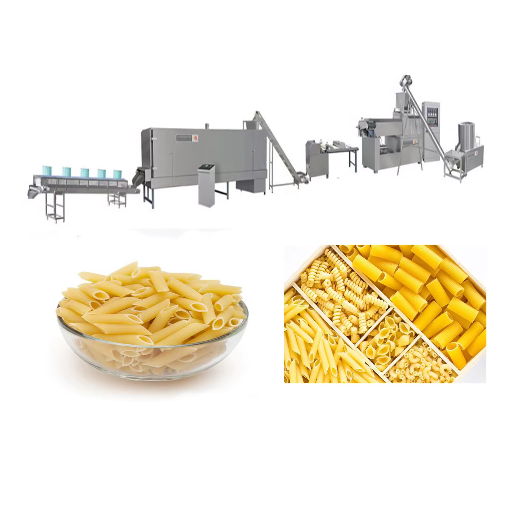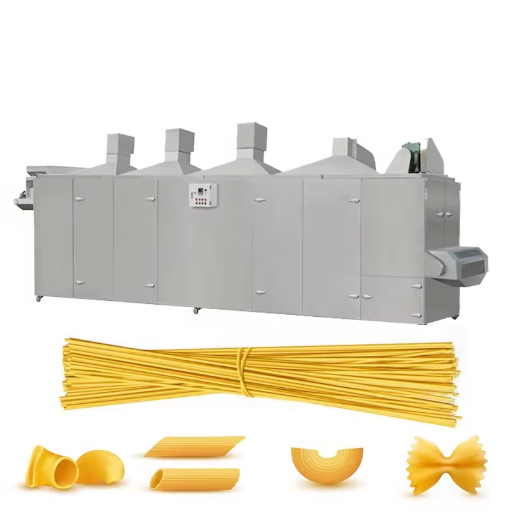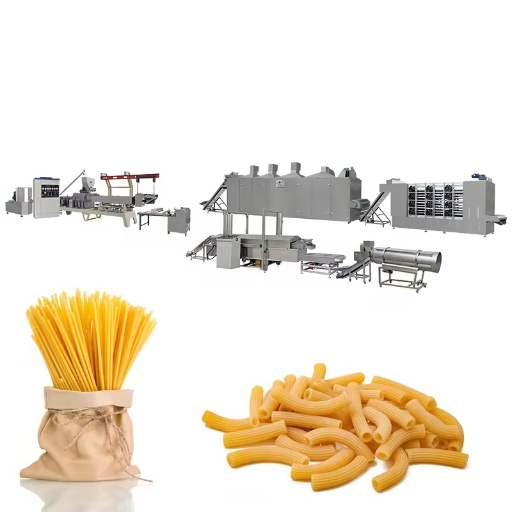Welcome to “Unlocking the Secrets of the Spaghetti Production Line,” where we unveil the intricate processes and advanced technology behind one of the world’s favorite foods. Starting from mixing the raw materials to packing, we shall walk you through all stages involved in spaghetti production line and provide an insight into ways and means that turn simple ingredients into global Italian food. This guide is designed to be a comprehensive one that would give information about modern food processing not only for culinary experts but also for people who have interest in wonders of contemporary food manufacturing. Come along as we unravel the art and science behind each strand of pasta which lands on your dish perfectly cooked.
What makes a spaghetti production line efficient?
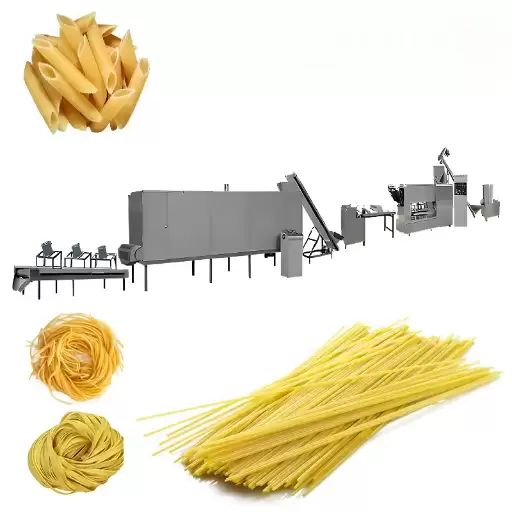
Key elements of a high-efficiency pasta production line
The success of a pasta production line depends on several significant factors, which are vital for ensuring the quality of output is high and operations run smoothly.
- High-Quality Raw Material Feed Systems: High-grade raw materials are the basis of excellent pasta. For efficiency purposes, automated lines offer consistent blending (mixing) between flour, water, and eggs.
- Advanced Extrusion Equipment: Central to this process is where dough is transformed into a range of shapes including spaghetti. New-generation extruders achieve uniformity in texture and size, which are essential for quality.
- High-Efficiency Drying Tunnels: Proper drying helps to prevent sticking together or rotting of pasta. The modern drying tunnels can change the temperature and humidity levels depending on the type of pasta being dried hence improving the efficiency in the manufacturing process.
- Cutting Edge Automation and Control Systems: All stages, from a mix-up to pack, are monitored closely by these systems to ensure they meet strict quality standards whilst maximizing throughput.
- State-of-the-Art Packaging Solutions: To keep them fresh longer as well as extend their shelf life, there is need for fast packaging systems. Their packaging allows customization according to market needs such as different packages sizes and materials available therein.
Integrating these components into one’s pasta production line will significantly increase efficiency, product quality, and operational consistency, setting the benchmark for high-performance food manufacturing.
The role of automation in enhancing spaghetti production line efficiency
Automation plays an important role in enhancing efficiency in spaghetti production lines through simplifying tasks, reducing human errors, and increasing output rates. It also provides accurate control over both initial constituents’ characteristics as well as the final products. Take mixing automation, for example, which has enabled constant dough quality, facilitating high-quality spaghetti. Moreover, automating extrusion processes ensures that similar shape & texture while advanced packing machinery seals effectively, thus increasing the longevity of the product on shelves. Right from packaging to drying, automation has enabled real-time monitoring and adjustments, thus reducing wastage while optimizing energy usage, hence a more sustainable production line. Overall, automation increases efficiency during spaghetti manufacturing while maintaining the best quality products.
Maximizing Production Capacity: Essential Considerations
Several key factors must be considered and optimized to maximize production capacity in spaghetti production lines. Knowing them can help you run an efficient production line that always maintains high-quality standards. Below is a breakdown of these important considerations:
- Raw Material Quality and Consistency: Consistent, high-quality raw materials are the basis of good spaghetti. Reliable quality results in less industrial waste and disturbance during domestic product development. This also involves regular supplier appraisals and quality control checks.
- Advanced Machinery and Equipment: Every production stage requires investment in top-of-the-range machinery, such as modern extruders, drying systems, and packing machines. With adequate technology, productive time will be wasted less, and the output rate will increase.
- Automation and Control Systems: Employing up-to-date automation systems enables producers to manage various manufacturing processes accurately. This ensures that there are no variations in product quality, hence low labor costs and faster adaptability to changing market trends.
- Efficient Workflow Design: The layout should encourage seamless flow between tasks with minimal stops or excessive handling. It means that the transfer from one phase to another throughout the entire production process (from mixing to packaging) is quick.
- Training and Skilled Workforce: A well-trained workforce is essential for any company, especially those operating complex plants with automated machines like pasta plants. Skilled operators ensure effective management of such equipment by detecting faults promptly and enhancing manufacturing process improvement efforts.
- Regular Maintenance: Scheduled servicing can avoid unplanned machine stoppages. Proactive maintenance and parts replacement before they fail may help prevent costly breakdowns.
- Quality Control Systems: A robust quality control system at different stages of production can help identify and fix problems before the final product. This ensures high standards without waste.
- Energy Efficiency: Reducing energy consumption lowers costs and promotes sustainable production principles. When available, assess and optimize the energy machines consume and consider renewable sources.
- Scalability: Plan for future production expansions. In this regard, machinery choices should not be inflexible; they should allow for scaling up output without redesigning everything.
By properly handling such considerations, spaghetti-making plants can increase their efficiency, enhance the quality of their products, and boost their production rates significantly. Maximizing your assembly line potential is dependent upon good planning and constant fine-tuning.
Choosing the right machinery for your pasta production line
Selecting Pasta-Making Machines – Essential Factors to Consider
When choosing pasta-making equipment for your production line, there are several critical factors you need to take into account that will ensure efficiency, scalability, and quality.
- Capacity and Speed: The machine should accommodate your production needs while determining demand and growth prospects. Speed is also important as it affects the total volume of production.
- Versatility: Choose machines that can make pasta of different shapes and sizes. This way, you can sell a variety of products without making substantial new investments.
- Durability and Maintenance: Long-lasting high-quality machines lead to less downtime and reduced maintenance costs. Select machinery with a solid history of reliability as well as easy support.
- Energy Efficiency: Machines with better energy efficiency will not only lower operating expenses but also promote environmentally friendly manufacturing practices. Take note of energy use and the potential for renewable integration.
- Quality of End Product: Make sure the machine can consistently produce pasta at high standards, meeting specific texture, shape, and composition requirements, among others, you may have set.
- After-Sales Support: Dependable after-sales support is very important because it enables quick resolution for any operational issues thereby reducing downtime. Evaluate manufacturer support services such as the availability of spare parts and technical advice or guidance offered by them.
By prioritizing these factors, you can choose the appropriate machinery for your pasta production line, allowing increased productivity and ensuring product quality while planning for future growth expectations.
Understanding Extruders vs Roller Machines in Pasta Making
Commercial pasta making has two main categories of machines; extruders and rollers which are necessary for selecting the right machinery suitable for your specific type of production line.
- Types/How Pasta is Formed:
- The extruder pushes dough through dies, forming diverse pasta shapes. It is quite flexible when producing different types of pasta, from spaghetti to fusilli or penne-shaped ones, which may be complicated in nature.
- Rollers are mostly used to make flat pasta, such as lasagna sheets or fettuccine. The dough is rolled out into the desired thickness and then cut into a favorite form.
- Texture and Quality:
- The pasta produced by extruders often has a rough texture because of the process; this helps the sauce adhere better to pasta.
- On the other hand, roller-made pasta usually has smoother surfaces with a delicate texture that is suited for certain recipes or preferences.
- Production Volume and Efficiency:
- Generally, extruders are better suited for high-volume production runs as they can create pasta shapes continuously at a much faster rate.
- Rollers, on the other hand, may be slower and require more human intervention, making them suitable for small-scale businesses or specific types of premium-quality pasta.
- Versatility:
- Both machines are versatile, but extruders are even more versatile, producing different shapes and sizes, which makes them ideal for businesses looking to produce various pasta products.
- Nevertheless, rollers are confined in areas of flat pastas although this cannot be matched when it comes to extremely thin delicate varieties they make.
- Operational Costs and Complexity:
- The operation and maintenance of extruders can be complex, requiring specialized personnel; nonetheless, what makes their employment worthwhile for larger establishments is how efficient and productive they are in running such operations
- Roller machines tend to be less complicated, potentially leading to low initial costs. They are also easy to maintain, thereby finding utility among individuals engaging in laser activities or targeting niche markets.
In brief, your production aims, pasta type you want to make and the money that you are willing to invest in the equipment as well as training will determine if you go for extruders or rollers. Both have their own merits and are suitable to some extent in specific markets of pasta making world.
The significance of finding an reliable pasta production line supplier
A pasta manufacturer needs to choose a reliable supplier of pasta production lines because it is critical for successful long-term operation and development of this sector. Apart from providing their clients with durable and efficient machines, these suppliers also offer essential after-sales services such as maintenance and sales of spare parts. This relationship ensures there are minimal downtimes while maintaining steady levels of output. Besides, by having an honest provider’s partnership one can obtain insights on how best they can improve the process which will help them keep pace with industry developments. As a result, proper selection of your supplier could make a huge difference in terms of both operations efficiency and product quality which will subsequently affect competitiveness on the market.
The future of spaghetti production: Trends and innovations
How sustainability is impacting pasta production line technology
Sustainability is increasingly becoming a critical factor in the evolution of pasta production line technology. Manufacturers are currently working on coming up with machines that use less energy, reduce water consumption and minimize waste. For instance, there is a considerable decrease in energy used by modern extruders and dryers while water recycling systems are being integrated to allow the reusing of water at least once in the process of making these products. Additionally, this also entails use of longer-lasting materials and components that can be recycled during manufacturing process hence reducing any carbon emissions as well as increasing longevity for such equipment. Similarly, the adoption of smart technologies in pasta production lines will help control production procedures precisely, thereby raising efficiency levels while minimizing resource wastage. Consequently, Environmental conservation pertaining to pasta manufacturing has affected not only the environmental impact but also technological advancement, operational efficacy, and potential cost savings into the future.
The role played by smart technologies in future-making processes
Integration of Smart Technologies into Pasta Making Processes Will Revolutionize the Industry by improving Efficiency, Quality, and Sustainability. The following are key areas where smart technology has a major effect:
- Precise Control: By using clever sensors plus AI algorithms, it is possible to manage accurate quantities, thus adjusting for moisture or temperature change. This helps keep pasta quality consistent while saving on wasted raw materials.
- Energy-Efficient: Advanced monitoring systems can optimize energy usage throughout the entire manufacturing process, from the mixing stage to the drying point, which reduces costs and lowers carbon footprints.
- Predictive Maintenance: Predictive maintenance tools analyze machine data to predict possible faults before their incident, thus avoiding downtime and improving machinery lifespan.
- Supply Chain Optimization: With IoT devices, ingredient sourcing, production, and movement can be monitored in real time, ensuring seamless supply chain management. This leads to fresh pasta with few, if any, delays.
- Customization at Scale: This allows efficient customization of pasta shapes, sizes, and varieties based on consumer demand without compromising productivity.
Innovations in Drying Processes for Higher Quality Dry Spaghetti
Drying processes are a key concern in the production of high-quality dry spaghetti and this has led to groundbreaking innovations in the pasta production industry. Some of these advancements include:
- Controlled Drying Environment: In modern drying technologies, it is possible to primarily regulate the level of humidity and temperatures present throughout the drying process. By creating an ideal environment for drying, manufacturers can avoid cracking and excessive brittleness, thereby preserving its texture and consistency while ensuring that the product remains intact.
- Adaptive Drying Cycles: Integration of smart sensors with AI algorithms led to development of adaptive drying cycles which change depending on moisture content in spaghetti as well as environmental conditions thereby ensuring evenness during drying period hence better quality.
- Energy-efficient Drying Technologies: Innovations in energy-efficient drying methods such as infra-red drying and heat pump technology do not only reduce the amount of energy consumed but also lower carbon footprints associated with drying processes These methods provide a sustainable alternative for attaining desired level of dryness without damaging pasta quality.
- Batch versus Continuous Drying Systems: Renovating traditional batch drying to continuous drying promotes steadiness in quality and enhances efficiency. Pasta is passed through the dryer in a constant flow manner, which facilitates an even distribution of heat and air improving the quality of dried spaghetti.
Therefore, these improvements in drying technologies ensure that pasta meets consumer expectations for quality, palatability, and sustainability.
How to start your own pasta production line
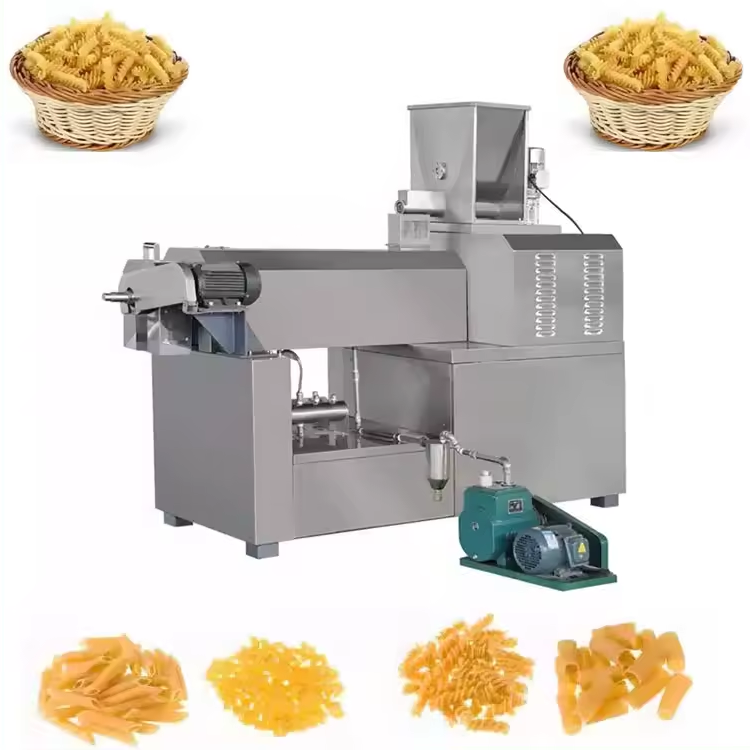
A simplified step by step guide to the establishment of a spaghetti production line
It can be an exciting experience for entrepreneurs who want to join the food manufacturing industry by starting a spaghetti production unit. Below is a simple step-by-step guide that will help you get started:
- Conduct Market Research: Determine how much spaghetti is needed, identify your customers, and examine competitors. This information will help you determine the size of your operation and decide what products to provide to gain market share.
- Develop a Business Plan: Be specific about what you want your business to achieve, how it should operate, its financial forecasts as well as its structure. You may need this document when seeking finances or loans.
- Find a Suitable Location: Look for facilities within reach from where ingredient drops-offs and finished goods pick-ups can happen; comply with local regulations on food producing premises and ensure enough room is available for machinery and storage.
- Purchase Equipment: If necessary, acquire machine tools for mixing, extruding, cutting, drying, and packaging your pasta. Depending on capacity requirements, consider both new and used equipment to balance cost with efficiency.
- Source Quality Ingredients: Identify consistent suppliers of high-grade semolina or flour, water, etc., which are required in making pasta. Consistency in ingredients quality is critical for superior products.
- Implement Safety and Health Standards: Understand food safety policies at local level that your production facility must adhere to; this might involve setting up cleaning regimes, training personnel about hygiene practices as well ensuring proper handling as well as storage of inputs.
- Hire Skilled Workers: Have employees who have skills that can be applied throughout various stages of the entire process such as machine operators; quality control analysts among others.
- Develop a Packaging and Branding Strategy: Design packaging materials that retain product freshness while appealing specifically to the target customer group. Strong branding will make all the difference between one product and another when placed upon retail shelves.
- Establish Distribution Channels: Work with retailers, wholesalers, and online marketplaces to ensure that your pasta reaches consumers. You might also consider going straight to customers through a corporate website.
- Launch Marketing Campaigns: Advertising on social media, food blogs, sampling events or local restaurant partnerships are some of the ways you can generate public awareness for your spaghetti. Sampling events and collaborations with local restaurants or chefs can also boost visibility.
While starting a spaghetti production line requires detailed planning and execution, it has the potential to become a successful and profitable endeavor if approached correctly.
Necessary equipment and budget considerations for new entrepreneurs
For a new entrepreneur getting into spaghetti, it is important to know the necessary equipment and financial aspects involved. A commercial pasta maker or extruder for instance is vital in producing large quantities of spaghetti. Moreover, one has to purchase a good dough mixing machine, drying racks or cabinets as well as packaging machines so as to maintain production efficiency. In terms of budgeting, these start-up costs may vary greatly but can be estimated between $20,000 and $100,000. Such a wide range factors in disparities linked to equipment quality and capacity plus the scale of output targeted by your firm. Note that high-grade equipment improves product quality and consistency on which consumer trust is based. Furthermore, some funds should also go towards product safety compliance (for food processing businesses), raw materials procurement, hiring talent pool and marketing/ distribution costs. Prioritizing expenses impacting directly on product quality and regulatory compliance from the outset will give you a firm foundation.
Regulations and certifications for pasta production businesses
Regulatory issues are an essential part of any pasta manufacturing business because they help ensure consumer accountability. In the US, for example, the Food and Drug Administration (FDA) sets guidelines regarding how foods are manufactured, packaged, and labeled and their safety regarding products such as pasta. These rules require adherence to Current Good Manufacturing Practice (CGMP) regulations that guarantee safe food production under hygienic conditions.
Therefore, companies aiming to export pasta must not only understand but also conform with regulatory requirements set by target markets so as not to lose out on such opportunities. This could mean obtaining additional certifications or standards like BRC Global Standard for Food Safety or ISO 22000 that focus more on quality management systems about food safety.
Moreover if your pasta production emphasizes organic ingredients then it will be imperative for you have organic certification such USDA Organic label which means you have complied with specific agricultural practices where ingredients are sourced from and how production is done.
The last one is Halal or Kosher certifications that can give access to a broader market with special dietary needs and preferences which could be obtained. Each of these certifications has their own set of rules and procedures ensuring that the products adhere to religious dietary standards required for any other type.
To summarize, pasta manufacturing businesses must take into account all pertinent regulations as well as obtain any necessary certification in order to perform successfully and reach out to more customers.
Understanding the spaghetti production process from start to finish
The role of flour quality and types in spaghetti production
Good spaghetti quality is the basis of its final appearance, as well as some of the benefits a consumer gets from it. For example, high-quality flour will ensure that spaghetti has a chewy texture which plays a critical role in consumer satisfaction. Choosing between semolina and durum wheat flour will determine such characteristics as color, cooking properties and shelf life of pasta. It has coarse texture inclusions with high protein content hence given firmness to spaghetti while keeping it intact during boiling due to its inherent ability to retain shape when cooked that makes it able to hold shape after being cooked. On the other hand, softer and finer durum wheat flour may be used to make smooth-textured ones. Therefore, manufacturers must select and mix flours properly according to desired properties of pasta balancing between consumers’ tastes and process needs.
From dough mixing to extrusion: stages of making spaghetti
Creating homemade pasta may seem like pure magic but it is actually an artful science that involves several steps. Here is an unstuffy look at one way this can happen:
- Mixing: This first step consists of blending chosen flour with water (sometimes eggs are added) into a paste known as dough. The type of water employed and amount of hydration for the dough are two critical factors here. The mixture should be mixed until a uniform dough is made before kneading it so as to enable gluten formation that gives structure and elasticity.
- Resting: After mixing, the dough needs to rest. This period allows the gluten networks to relax and enables even distribution of moisture throughout the dough making shaping easier.
- Extrusion: The rested dough then enters an extruder where it passes through dies which create its form e.g., for spaghetti round holes have been provided in specific width sizes at one end each die having varied precision or surface design so that these determine how our spaghettis appear at last during cooking; Extrusion may be conducted under different pressures or temperatures because each is known to have a unique effect on the dough.
- Cutting: The extended strands of dough are then cut into desired lengths. Spaghetti length sizes are standardized but this stage could be changed for other pasta types.
- Drying: The cut spaghetti is further dried to remove moisture. Drying is done at high temperatures and humidity and takes time into consideration. To achieve the right brittleness or softness, one has to control drying variables carefully.
- Packaging: Lastly, it is packed after cooling down to room temperature. Packaging serves many purposes including protecting against physical damage or contamination and providing consumers with brand identity as well as information about the product inside.
Each of these stages entails some considerations such as water content in the mixture, gluten development, die design/make up and handling of drying conditions. It is through these that manufacturers ensure that spaghettis not only taste good but form properly, cook well and meet consumer expectations fully.
Key factors determining ideal texture and flavor of pasta
To accomplish excellent texture and taste of pasta, an artful technique is required to ensure that certain factors are properly observed. To begin with, it is the quality of wheat used; high-protein durum wheat semolina is preferred because of its high gluten strength and elasticity necessary for pasta texture. Another factor that influences the dough’s consistency, a key determinant of the final product’s hardness, is water to semolina ratio. Furthermore, extrusion process precisely die material affects texture which bronze dies give a rougher surface that absorbs sauce better. The drying process is also very important as slow low temperature drying helps retain the natural taste of the pasta without making it too brittle. Raw material selection through precise production condition control has all these steps supporting excellence in cuisine for pasta which should have an ideal al dente feel and a full flavor experience when eaten.
From traditional to modern: The evolution of pasta production lines
How pasta production technology has evolved over the years
Looking back on developments in pasta production, I observe how much these changes have shaped the industry. In the past, making pasta was largely a process of hands-on craft and simple tools. The advent of industrialization brought about automated machines that did not only increase production but also made sure quality remained consistent. Nowadays, we are going through an era where digitalization and IoT technologies are beginning to show up – these allow for unprecedented precision in controlling variables in production, real-time monitoring of production lines and even predictive maintenance to reduce downtimes; moreover, advances in food science and materials technology have seen a revolution take place in ingredients as well as sustainable packaging solutions. This ongoing evolution signifies not just a pursuit of efficiency and scale but also a commitment to quality, sustainability, and meeting the diverse dietary needs of a global population.
Traditional Italian pasta making vs. industrial pasta production systems
Considering my culinary experience and technical knowledge of how pasta is produced the comparison between traditional ways of making Italian pasta and current industrial systems is starkly detailed. Pasta making is an art that has been passed down generations where every knead and roll tells a story about history or culture. Ingredients are often locally sourced with top priority being given to quality and naturalness: semolina flour from finest wheat grains mixed with pure clean water for instance. It takes time so that dough can rest naturally develop flavors.
In contrast, modern industrialized pasta factories focus on mass production systems which are efficient throughout its whole processing line thereby maintaining consistency all along the way. Whenever I visited some of the newest facilities out there it became clear that much still has to happen before we can completely automate our processes like other leading manufacturers do every single day, producing several thousand kilos within each hour from their advanced machinery used at various points on the line such as mixers, extruders driers packagers etc.; data collected during this period is meticulously analyzed so as to make sure each batch meets the strictest quality criteria. Traditional pasta making, though, provides that special touch which only a mother can give from her kitchen but industrial systems guarantee uniformity and remain accessible all over the world.
This dichotomy goes beyond mere quantity; it is also a philosophy of how food should be made. The traditional way of doing things in Italy exalts the art and experiential aspect of eating pasta – which is difficult to replicate on an industrial scale. However, current ways have enabled millions of people around globe to get good quality noodles thus ensuring food safety and sustainability via resource management along with novel practices such as these: this contrast amazes me because it reflects both the traditions of yesterday’s cuisine and tomorrow’s dreams about what we will discover through culinary arts in future – the duality between past and future in pasta production.
The impact of modern machinery on the quality of pasta products
The standard of pasta products has been changed by the use of modern machines in their manufacturing process, with the introduction of some improvements and uniformity. In an expert’s opinion, this advanced technology brings about uniformity in shape, size and texture which is critical for ensuring that any consumer can cook it consistently. Additionally, industrial production gives minimal chances for contamination due to its controlled environments. This means that although the mechanization process ensures unprecedented efficiency and consistency, it may fail to capture the intricate flavors and textures found in handmade pasta. The acceleration of drying process in commercial firms for instance distorts the ability of pasta to hold sauce as well as its overall mouth feel. Indeed, safety enhancements have resulted from modern machinery in pasta production; therefore making it more available and consistent but still maintaining a lot of complexities with respect to traditional culinary values and quality associated with artisanal workmanship such as in case of pasta making.
Unlocking the Secrets of the Spaghetti Production Line: A Comprehensive Guide
The following sources have been meticulously selected to provide a thorough understanding of the intricacies involved in spaghetti production. These resources span a variety of formats and offer a wealth of knowledge, from technical insights to in-depth analyses, suitable for individuals seeking to comprehend the complexities of spaghetti manufacturing processes.
-
The Science and Technology of Industrial Pasta Making
- Summary: Published in a peer-reviewed journal, this article offers an authoritative exploration into the science and technology underpinning pasta production, with a focus on spaghetti. It comprehensively covers the materials, machinery, and methodologies employed in the industry, offering readers a deep dive into the technical aspects of production. The article’s strength lies in its detailed explanation of the production phases, from dough preparation to drying processes, making it an invaluable resource for individuals aiming to gain a solid understanding of spaghetti production from a scientific standpoint.
-
Advanced Automation in Pasta Manufacturing: An Industry Insight
- Summary: Through this source, readers gain access to cutting-edge research on automation technologies in pasta production lines, including spaghetti manufacturing. The document, available on the IEEE Xplore digital library, examines the role of automation in enhancing efficiency, quality, and safety in food processing. With a detailed analysis of automated systems for mixing, extrusion, cutting, and drying, the article is pivotal for professionals looking to understand the technological advancements driving the pasta industry forward.
-
Pasta Production Technology – Manufacturer’s Guide
- Summary: Bühler Group, a leading manufacturer of food processing equipment, provides an in-depth look at the spaghetti production line through this comprehensive guide. It covers the entire production process, offering insights into the equipment used at each stage, from raw material handling to packaging. This source stands out for its practical approach, detailing the technical specifications, operational principles, and maintenance practices critical for optimizing spaghetti production. Its relevance is underscored by Bühler Group’s extensive experience and authority in the field, making it a must-read for those interested in the operational aspects of spaghetti manufacturing.
These sources collectively shed light on the complexities of spaghetti production, from the scientific principles that guide the manufacturing process to the latest technological advancements in automation and equipment. Each resource has been selected for its credibility, depth of information, and relevance, ensuring that readers are well-equipped with the knowledge to explore the spaghetti production line comprehensively.
Recommend reading: Mastering the manufacturing process of Spaghetti.












